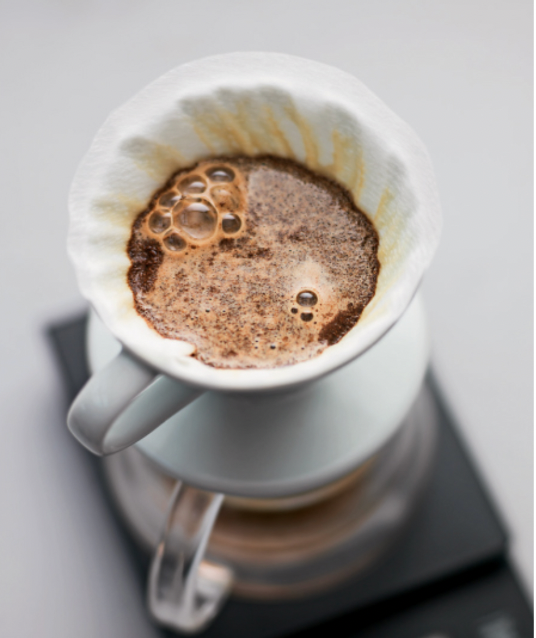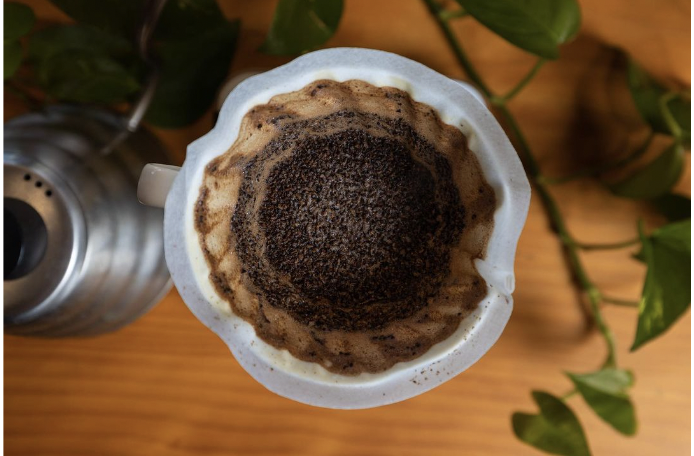New Year Pouring Over
Feels like 2024 is already flying by! It’s been about a month since the last broadcast, and what a month it’s been. Like most others, we’ve used this first few weeks to dig in some self-reflection: what worked, what didn’t, and what we want to be when the 2025 ball drops. This means some of us are creating new habits, while others are leaning into old ones we want to keep around.
At Cog, we’re doing all of the above. In this edition, we’re going to highlight pour over brewing through the lens of ‘tried and true’ methods while incorporating the latest science and insights.
Hot shot.
3.12
~ The new Guiness Record for Fastest time to drink a cup of coffee, set by Felix von Meibom
Right to the dome.
Makeover for your pour overs.
Pour overs. Hand brews. Filter brewers. All of these names describe the brew method that is based on percolation. Percolation means water passes through a bed of coffee, extracting deliciosity along the way.
Typically, some sort of material filters the grounds from the finished drink, whether it’s a paper, cloth, or a fine metal mesh. There are a wide range of pour over brewers, brands, and devices. They each have their own advantages and quirks. Thankfully, the principles of brewing a quality pour over is universal, and can be adapted to any set up you prefer.
In this section, we’ll review each of the principles, culminating with our recommended pour over recipe at the end.
The Pour Over Principles.
Find the amount of coffee that works for you.
The amount of coffee, or dose, sets the table for the pour over brew you end up with at the end. Bearing in mind that the typical “cup” of coffee is about 300 grams, the dose decision informs all the variables in the brew: strength, clarity, mouthfeel, and many others.
A quick way to determine the amount of coffee to use is by coffee-to-water ratios. With pour over brewing, most ratios range from 1-to-15 (which is a higher dose) to 1-to-18 (which is a lower dose).
At Cog, we tend to prefer 1-to-16 ratios (1 part coffee to 16 parts water). So if you’re aiming for a 300 gram output (which is about ten and a half ounces), dividing 300 by 16 gives you roughly 19 grams of coffee.
Mind the grind.
The finer the grind, the more flavor we can pull from the coffee.
A rule of thumb for finding the right grind for pour over coffee is to start with the grind that’s bang middle of your grinder. Drink your brew and ask:
1) Is it bitter or dry? If so, you likely want to explore coarser grind settings.
2) Is it bland or flat? If so, you likely want to explore finer grind settings.
3) Does it have some brightness with a detectable mouthfeel? If so, you nailed it right out of the gate! Good work, you should celebrate with another delicious pour over.
At Cog, we tend to keep the grind for our pour over recipe on a medium setting.
Control your flavor with contact time.
Water pulls (or extracts) all the flavors (or solubles) we experience from coffee. The faster the water flows, the less we are pulling from the coffee. The inverse is true too–– the slower the coffee flows, the more we are extracting.
Pour overs need to be in bloom.
When you first start a pour over, you’ll notice bubbling, as well as the coffee bed swelling like dough.
This phase is crucial because one of the major byproducts of roasting coffee is carbon dioxide gas. When you hit the coffee grounds with hot water, CO2 escapes and bubbles out. The problem is that if carbon dioxide gas is going out, water isn't able to get in.
Picture shoppers waiting on Black Friday. Right before you open, the building catches fire. If you opened the store, you’s have a traffic jam… unless everyone wanting in waited until those wanting to get out, well, got out.
When starting a pour over brew:
Add just enough water to wet the grounds.
Then stop, and let the gas escape for about 30 seconds. - - You'll see the coffee beds well and expand.
(this is the “bloom”).
This helps the coffee grounds fully saturate, and extract solubles from the center of each coffee particle.
Get yourself a flat bed.
A visual cue for a quality pour over is having a flat coffee bed upon its finish. This indicates an evenness in taste, whereas peaks and valleys suggest “channeling”.
An approach to ensure an even brewing of a pour over is judicious stirrig, especially during the bloom stage. This reduces channeling, makes extractions more uniform, and improves repeatability.
A final note on the pour over principles.
Good pour overs tend to keep all of these variables consistent. Accidentally changing the grind setting or skipping the bloom stage will give surprising or confusing results.
The Cog pour over recipe.
At Cog, we prefer the V60, but this recipe will work on any pour over brewing system.
Dose: 24g
Yield: 384
Ratio: 1:16
Grind: medium
Begin with clean equipment.
Place filter in pour-over brew basket, set on top of decanter. Preheat by pouring hot water through. Discard this water.
Place the brew basket with filter on a cup, and put everything on the scale. Add the coffee to the filter and then tare the scale.
Pour 60 grams of water over the coffee. Make sure to saturate all the grounds thoroughly, and give the coffee bed a stir.
Start timer, and allow to bloom for 30 seconds.
Continue to slowly pour the remaining 324 grams of hot water, pouring roughly 5 grams per second.
Give the pour slurry one gentle stir, in a clockwise stir. Direction.When the water level is drawing down, give the brewer a little shake to keep the coffee bed flat.
When all the water has been poured over the grounds and the filter has begun to drip very slowly, remove and discard the filter.
Pour over imports from the coffee community.
James Hoffman’s most recent V60 recipe. TikTok
Lance Hedrick’s flash brew pour over recipe. YouTube
Scott Rao’s pour over analysis. Blog
The Rao Spin. YouTube
A professor teamed up with a volcanologist to show scientifically that the addition of water pre-grind leads to a more consistent shot of espresso. Blog






